Should teacher numbers drop as school rolls fall?
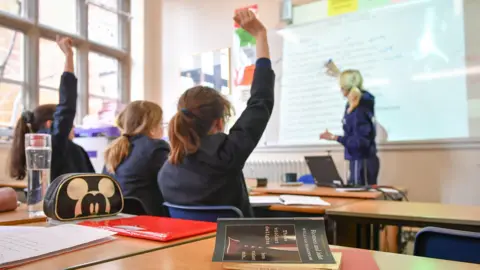 PA Media
PA MediaLong-term plans need to be drawn up for Scotland's schools to reflect falling pupil numbers, a think tank has said.
The Institute for Fiscal Studies (IFS) said there could be 90,000 fewer pupils in the country's classrooms by 2040 - and suggested that teacher numbers could be cut as a result.
The group said this could eventually free up £500m per year, but the government has flatly rejected the idea.
Teaching unions have hit out too, with the EIS saying cutting teacher numbers "lacks any educational rationale" and the NASUWT calling it a "false economy" that would damage life chances and Scotland's future prosperity.
But when you consider the falling birth rate and demographic changes alongside the need to get the maximum benefit out of every pound spent on services, is it time to talk about teacher numbers?
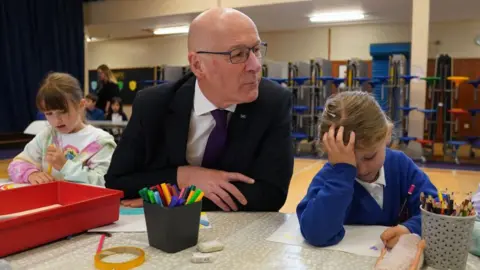 Getty Images
Getty ImagesSchool staffing is a frequent topic of dispute between politicians - usually in terms of demands for more of them, not fewer.
The SNP pledged in its 2021 manifesto to increase teacher numbers by 3,500.
So when it was revealed in December that the figure had actually fallen, opposition leaders were quick to give the first minister a hard time about it.
John Swinney pledged to get teacher numbers back to 2023 levels, and keeping them there is the government's new goal.
But pupil numbers are already starting to plateau, and are projected to drop sharply over the coming decades.
That's why the Institute for Fiscal Studies argues that perhaps it would be OK to allow teacher numbers to go down in line with that, rather than holding them at 2023 levels.
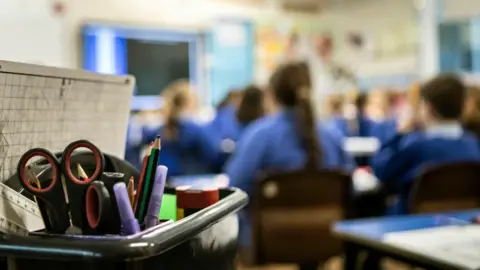 PA Media
PA MediaThe government has flatly rejected the report's conclusions.
But much of the picture it paints is actually pretty positive.
The IFS underlines that class sizes in Scotland are smaller than those elsewhere in the UK - averaging about 13 pupils per teacher, compared with 17 to 19 pupils per teacher down south.
Spending per pupil is also rising, and is the highest in the UK - 20% higher than it is in England.
But on both counts that can be explained in part by the number of pupils rising far more sharply south of the border. Scotland is set to have the opposite problem.
The stickiest issue for the government is that these smaller class sizes and higher spending hasn't necessarily led to notably better outcomes.
Scotland's struggle in international comparisons of school performance has been well documented. There has been a long-term decline in reading, maths and science, and Covid has hardly helped.
The gap in attainment between pupils from more and less affluent backgrounds also remains stubbornly unclosed, almost a decade on from it being made the government's "number one priority".
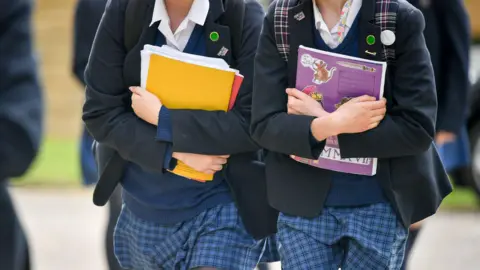 PA Media
PA MediaThe IFS argument is that continuing to plough money into school staffing against a backdrop of falling school rolls isn't the most cost-effective way to improve things.
Pupil numbers are projected to fall by 90,000 by 2040. If teacher numbers hold steady at 2023 levels, then the pupil-teacher ratio will fall closer to 12 - the lowest ever.
But IFS research economist Darcey Snape says smaller class sizes "only tend to have modest effects on pupil attainment".
Her analysis suggests that letting teacher numbers fall could free up funds - up to £500m per year by 2040 - either for other areas of schooling, or indeed for other badly-stretched budgets such as social care.
Ms Snape accepts there would inevitably be "practical difficulties", like amalgamating classes and schools as rolls fall - but says local councils are arguably best placed to make these decisions, "rather than applying a one-size-fits-all approach across Scotland".
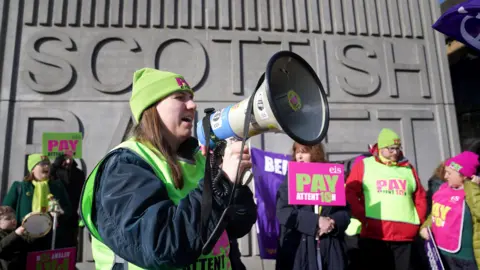 PA Media
PA MediaThe latter point is already the subject of some dispute between schools and councils.
Ultimately councils are the employers, and control the overall numbers - the government can only enforce its policy by holding carrots and sticks over them.
Education Secretary Jenny Gilruth has clashed with council leaders by threatening to withdraw funding which was offered on the basis of keeping numbers at 2023 levels.
A deal has just been struck with Glasgow City Council, which was planning on cutting 450 posts over a three-year period - which in turn had led to strike threats from unions.
Groups representing teachers are predictably negative about the IFS's report, calling it a "false economy" and a "race to the bottom".
The EIS and NASUWT say things aren't as straightforward in schools as the report might make out.
Both make the point that the number of pupils with additional support needs has risen to record levels. They need more support, not less, and cutting teacher numbers would "further entrench existing inequalities" in their prospects.
They also point to the fact teachers already have "excessive workloads and working hours", and face issues with anti-social behaviour and even violence in classrooms.
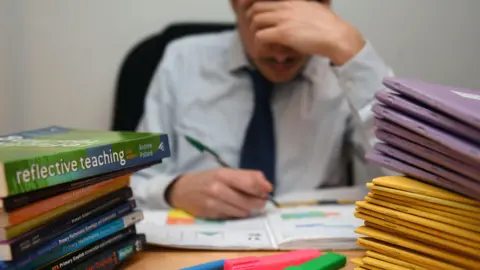 PA Media
PA MediaIt is absolutely fair to argue that long-term planning needs to be done, to take account of shifting demographics.
The ever-increasing strain on care services provides a prime example of why we need to be ready for the ways in which society will change.
Perhaps we do need to have a grown-up debate about the best and most cost-effective way to improve outcomes in schools.
But when the headline is getting rid of teachers, it's always going to be difficult to sell the idea to politicians who face an election in just over a year.
The Scottish government has already flatly rejected the idea, saying teachers play a central role in driving improvements in schools.
And as noted above, opposition parties are chiefly interested in holding ministers to account on their promised increases. Nobody is going to put cutting teacher numbers on a leaflet.
And it's particularly tough to get MSPs to stick their necks out when we're talking about something which will be an issue in 2040, which feels pretty distant.
But a year is famously a long time in politics, and 15 of them is an eternity. Look back 15 years and Gordon Brown was prime minister and the SNP were being propped up by the Conservatives at Holyrood.
If one thing is guaranteed, it's change; it's incredibly unlikely that we will reach 2040 with the current policy structure intact.
Unless something also shifts in terms of Scotland's birth rate and the pace of demographic change, decisions are going to be needed sooner or later.
